
Let’s talk for a moment about life cycles. Companies have them, markets have them, and products have them. The trajectories for many product life cycles generally progress through well-defined stages: Introduction, growth, maturity and decline. I dare say that as boys become men, their health care shows a remarkably similar curve.
Men’s Health Lifecycle
Don’t believe me? Have a look at the life cycle of the typical American male “product” in the healthcare system:
Awareness. Pediatrician oversees care during infant and toddler phases.
Growth. Prepubertal development is monitored at school, at home and by a pediatrician.
Maturity. Teenage years. Pediatrician is still heavily involved.
Decline. After high school, young men dive into the workforce or to college and lose touch with medicine, basically dropping off the radar of health care. They only briefly surface for care, when men are in pain or their lives are threatened.
Could this be why men don’t live as long as women? Or why many of the leading causes of mens’ deaths are preventable? Possibly.
System Error
Another rather large issue is that the care offered to young adult men is bereft of “ownership” as medicine is relatively super specialized and highly siloed. Essentially, no single provider “owns” men, unlike gynecologists for women, which leads to their ongoing medical disengagement as adults.
Men as Commodity
“So what?” you ask. What’s good for our commercial products should suffice for our men. In a sense, I agree. We should consider men’s health a precious commodity, one that is critical to the economic well being of America. On the other hand, commoditizing health oversimplifies the fact that diseases begin a whole lot earlier in the human life cycle than previously thought.
Take infertility for example. Over the last decade it has become clear that male infertility correlates with decreased overall health. It also correlates with the later development of cancer. Erectile dysfunction shows similar correlations to future health and heart disease. This means that there is not just one, but potentially several, canaries in the coalmine of men’s health.
But what an opportunity! What better way for providers to get our foot in the door and improve the life cycle of men’s health than through helping men with sexual health issues that present earlier than many other diseases?
This month, two great big governmental entities, the NIHand CDC, arejoining forces along with key thought leaders, to address the relationship between fertility and disease. A strategic think tank session is planned in Washington and I will be there. Jazzed by the White House Dialogues held earlier this year, I hope to be an agent for change, to continue the momentum, and to generate action from the energy percolating around men’s health. We need to offer men something that never goes out of style: quality healthcare that engages them early and suits them to a T.
The post What Happens When Boys Become Men appeared first on The Turek Clinic.



